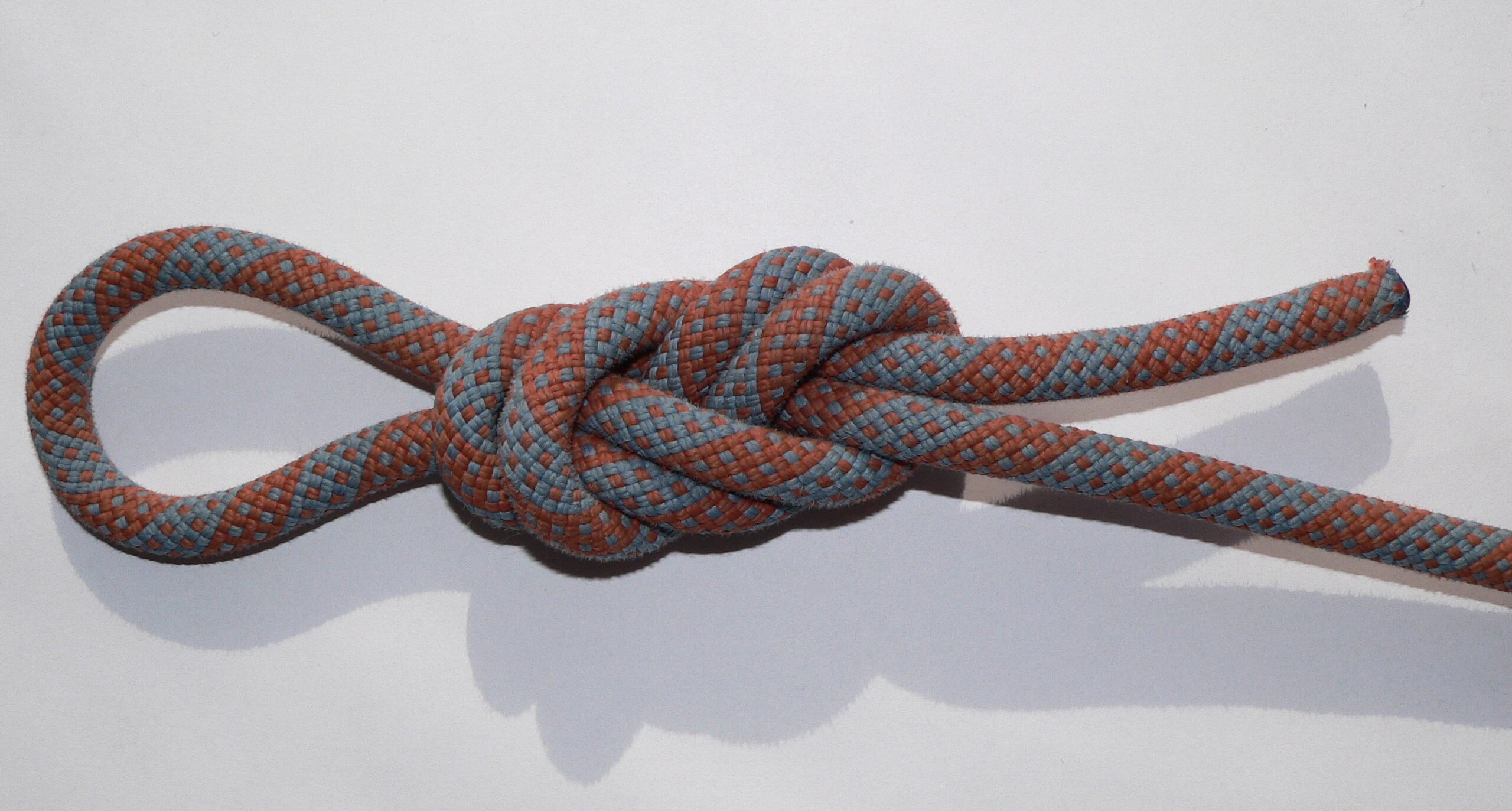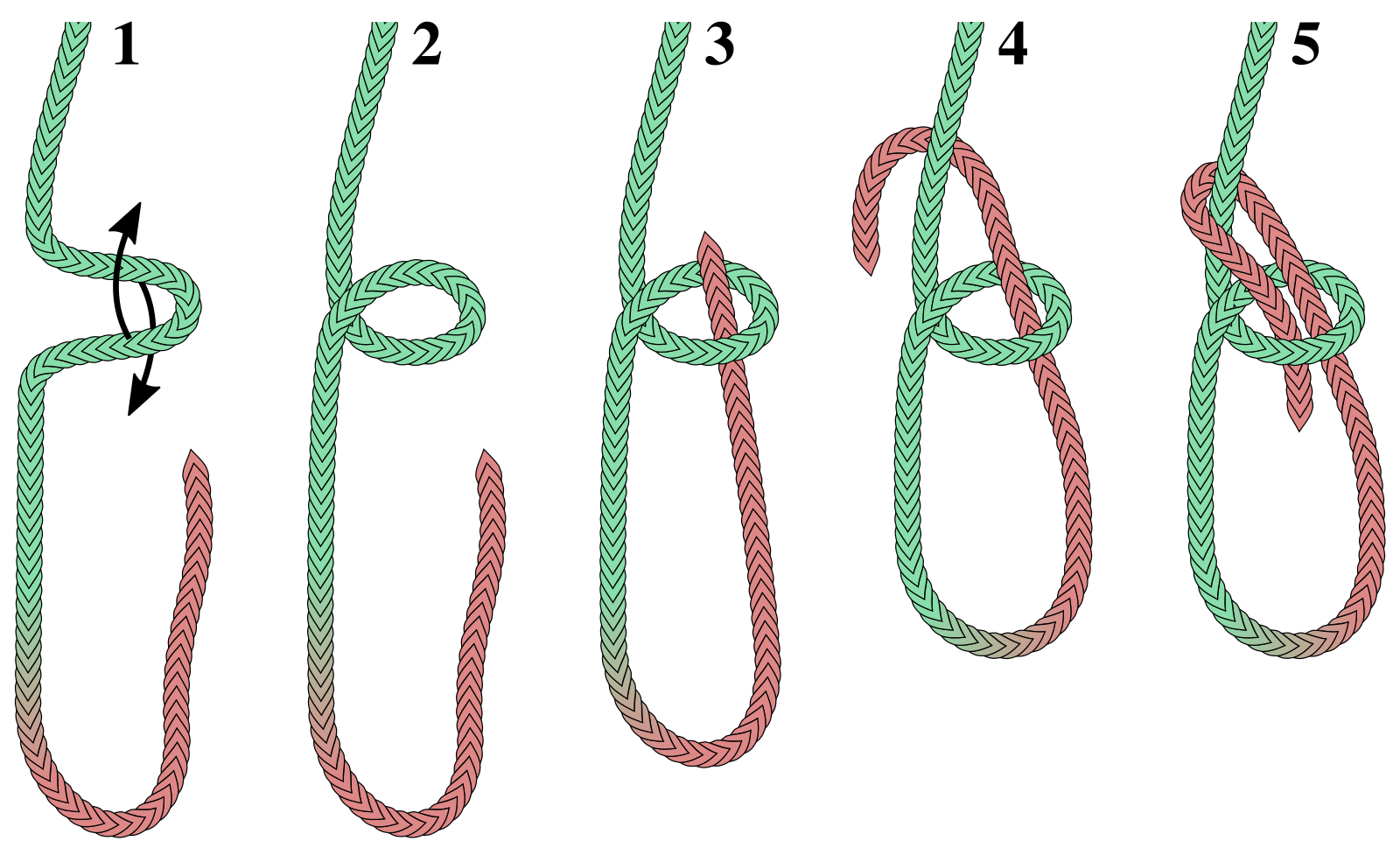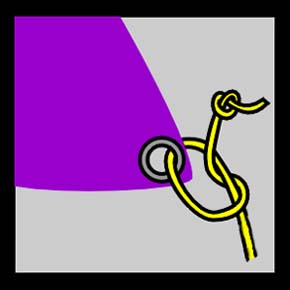|
Trident Loop
The trident loop is a fixed loop knot which can jam when heavily loaded. It was proposed as a replacement for the figure-of-eight loop for use in climbing by Robert M. Wolfe, MD, who developed it as a loop form of Ashley's bend. While some tests indicate its strength lies somewhere between the weaker Bowline and stronger figure-of-eight loop, the trident loop shows exceptional resistance to slipping in shock-loading tests.Geoffrey Budworth, ''The Complete Book of Knots'' (London: Octopus, 1997), 94. Tying Image:TridentLoop01.jpg, 1. Start with a rope end. Image:TridentLoop01.1.jpg, 2. Start an overhand knot, leaving enough rope for the loop and the rest of the knot. Image:TridentLoop01.2.jpg, 3. Complete the overhand knot. Image:TridentLoop02.jpg, 4. Form the loop by wrapping the working end around, and then form a bight in the working end. Image:TridentLoop03.jpg, 5. Feed the bight ''through'' the overhand knot. Image:TridentLoop04.jpg, 6. Wrap the remaining working end around t ... [...More Info...] [...Related Items...] OR: [Wikipedia] [Google] [Baidu] |
Ashley's Bend
Ashley's bend is a knot used to securely join the ends of two ropes together. It is similar to several related bend knots which consist of two interlocking overhand knots, and in particular the alpine butterfly bend. These related bends differ by the way the two constituent overhand knots are interlocked. History The name "Ashley's bend" is now associated with the knot described in entry #1452 of ''The Ashley Book of Knots''. Clifford Ashley developed this bend and believed it to be original, along with several similar ones. Rather than giving it a name he simply noted the date when he first tied it: "(2/3/34.)". Cyrus L. Day, a contemporary of Ashley's, called the knot by the name "Ashley's Bend" in his 1947 book ''The Art of Knotting & Splicing'' just a few years after the publication of Ashley's book.The name "Ashley's Bend" is only used in the index (p. 223) of the first edition (1947) of ''The Art of Knotting and Splicing'', not the main discussion of the knot on page ... [...More Info...] [...Related Items...] OR: [Wikipedia] [Google] [Baidu] |
Figure-eight Knot
The figure-eight knot or figure-of-eight knot is a type of stopper knot. It is very important in both sailing and rock climbing as a method of stopping ropes from running out of retaining devices. Like the overhand knot, which will jam under strain, often requiring the rope to be cut, the figure-eight will also jam, but is usually more easily undone than the overhand knot. The stevedore knot is the figure-eight knot with two half twists added before the end is finally stuck. Different types Figure-eight loop The figure-eight loop is used like an overhand loop knot. This type of knot can be used in prusik climbing when used in conjunction with a climbing harness, a climbing rope, and locking carabiner designed for climbing, to ascend or descend with minimal equipment and effort. Figure-eight bend The figure-eight bend knot is used to " splice" together two ropes, not necessarily of equal diameter. This knot is tied starting with a loose figure-eight knot on one rope ... [...More Info...] [...Related Items...] OR: [Wikipedia] [Google] [Baidu] |
Zeppelin Loop
A zeppelin eye knot, is a secure, jam resistant fixed size loop knot based on the zeppelin bend. It is one of the few eye knots suitable for bungee. It is also special in its ease of untying. Tying Virtually all bends (i.e. end-to-end joining knots) have a corresponding 'eye knot'. For example, the Sheet bend (ABoK #1431) has a corresponding eye knot which is none other than the common (#1010) Bowline. The Zeppelin bend is formed from 2 superposed loops of opposite chirality. There are two versions of the zeppelin eye knot depending on how it is tied. * The first version where the end seems to be vertical to the main part, and one of the loop sides seems to be the continuation of the main part, while the other loop side seems to continue as the working end out of the loop knot. This version is tied using the clover method, starting with an overhand knot, then letting the working end pass in the following order through # first the eye of the clover (overhand knot) on the mai ... [...More Info...] [...Related Items...] OR: [Wikipedia] [Google] [Baidu] |
Loop (knot)
This page explains commonly used terms related to knots. B Bend A bend is a knot used to join two lengths of rope. Bight A bight has two meanings in knotting. It can mean either any central part of a rope (between the standing end and the working end) or an arc in a rope that is at least as wide as a semicircle. "Any slack part of a rope between the two ends, particularly when curved or looped." In either case, a bight is a length of rope that does not cross itself. Knots that can be tied without use of the working end are called knots ''on the bight''. Binding knot Binding knots are knots that either constrict a single object or hold two objects snugly together. Whippings, seizings and lashings serve a similar purpose to binding knots, but contain too many wraps to be properly called a knot. In binding knots, the ends of rope are either joined together or tucked under the turns of the knot. Bitter end Another term for the working end. C Capsizin ... [...More Info...] [...Related Items...] OR: [Wikipedia] [Google] [Baidu] |
Knot
A knot is an intentional complication in cordage which may be practical or decorative, or both. Practical knots are classified by function, including hitches, bends, loop knots, and splices: a ''hitch'' fastens a rope to another object; a ''bend'' fastens two ends of a rope to each another; a ''loop knot'' is any knot creating a loop; and ''splice'' denotes any multi-strand knot, including bends and loops. A knot may also refer, in the strictest sense, to a stopper or knob at the end of a rope to keep that end from slipping through a grommet or eye. Knots have excited interest since ancient times for their practical uses, as well as their topological intricacy, studied in the area of mathematics known as knot theory. History Knots and knotting have been used and studied throughout history. For example, Chinese knotting is a decorative handicraft art that began as a form of Chinese folk art in the Tang and Song Dynasty (960–1279 AD) in China, later popularized in t ... [...More Info...] [...Related Items...] OR: [Wikipedia] [Google] [Baidu] |
Figure-of-eight Loop
Figure-eight loop (also figure-eight on a bight, figure-eight follow-through, figure-eight retrace, Flemish loop, or Flemish eight) is a type of knot created by a loop on the bight. It is used in climbing and caving. The double figure eight is used to put a loop in the end of a rope, or around an object. It is relatively easy to tie and is secure, but can become difficult to untie after heavy loading, and can jam badly in any rope type. Tying methods On a bight A figure-eight loop is created by doubling the rope into a bight, then tying the standard figure-eight knot. In climbing, this knot is used to save time when repeatedly attaching the rope to climbing harnesses, using locking carabiners, such as when a group of people are climbing on the same top-rope. Follow-through Alternatively, to tie the knot directly around an object, the follow-through method must be used. * Tie a regular figure eight knot with a significant amount of extra tail. * Loop the tail around the o ... [...More Info...] [...Related Items...] OR: [Wikipedia] [Google] [Baidu] |
Climbing
Climbing is the activity of using one's hands, feet, or any other part of the body to ascend a steep topographical object that can range from the world's tallest mountains (e.g. the eight thousanders), to small boulders. Climbing is done for locomotion, sporting recreation, and for competition, and is also done in trades that rely on ascension; such as emergency rescue and military operations. Climbing is done indoors and outdoors and on natural (e.g. rock and ice) and artificial surfaces. Professional mountain guides or rock climbing guides (e.g. the UIAGM), were a significant element in developing the popularity of the sport in the natural environment, and remain so today. Since the 1980s, the development of competition climbing and the availability of artificial climbing walls have dramatically increased the popularity of rock climbing as a sport and led to the emergence of professional rock climbers, such as Wolfgang Güllich, Chris Sharma, Lynn Hill and Catherine ... [...More Info...] [...Related Items...] OR: [Wikipedia] [Google] [Baidu] |
Bowline
The bowline ( or ) is an ancient and simple knot used to form a fixed loop at the end of a rope. It has the virtues of being both easy to tie and untie; most notably, it is easy to untie after being subjected to a load. The bowline is sometimes referred to as ''King of the knots'' because of its importance. Along with the sheet bend and the clove hitch, the bowline is often considered one of the most essential knots. The common bowline shares some structural similarity with the sheet bend. Virtually all end-to-end joining knots (i.e., bends) have a corresponding loop knot. Although the bowline is generally considered a reliable knot, its main deficiencies are a tendency to work loose when not under load (or under cyclic loading), to slip when pulled sideways, and the bight portion of the knot to capsize in certain circumstances. To address these shortcomings, a number of more secure variations of the bowline have been developed for use in safety-critical applications, or by s ... [...More Info...] [...Related Items...] OR: [Wikipedia] [Google] [Baidu] |
Overhand Knot
The overhand knot is one of the most fundamental knots, and it forms the basis of many others, including the simple noose, overhand loop, angler's loop, reef knot, fisherman's knot, Half hitch, and water knot. The overhand knot is a stopper, especially when used alone, and hence it is very secure, to the point of jamming badly. It should be used if the knot is intended to be permanent. It is often used to prevent the end of a rope from unraveling. An overhand knot becomes a trefoil knot, a true knot in the mathematical sense, by joining the ends. It can also be adjusted, faired, or mis-tied as a half hitch Tying There are a number of ways to tie the Overhand knot. * Thumb method – create a loop and push the working end through the loop with your thumb. * Overhand method – create a bight, by twisting the hand over at the wrist and sticking your hand in the hole, pinch the working end with your fingers and pull through the loop. Heraldry In heraldry, the overhand knot ... [...More Info...] [...Related Items...] OR: [Wikipedia] [Google] [Baidu] |
Bight (knot)
In knot tying, a bight is a curved section or slack part between the two ends of a rope, string, or yarn.. "Any slack part of a rope between the two ends, particularly when curved or looped." A knot that can be tied using only the bight of a rope, without access to the ends, is described as in the bight. The term "bight" is also used in a more specific way when describing Turk's head knots, indicating how many repetitions of braiding are made in the circuit of a given knot. Bight vs. open loop Sources differ on whether an open loop or U-shaped curve in a rope qualifies as a bight. treats bights and loops as distinct, stating that a curve "no narrower than a semicircle" is a bight, while an open loop is a curve "narrower than a bight but with separated ends". However, ''The Illustrated Encyclopedia of Knots'' (2002) states: "Any section of line that is bent into a U-shape is a bight." Slipped knot In order to make a slipped knot (also slipped loop and quick release knot), ... [...More Info...] [...Related Items...] OR: [Wikipedia] [Google] [Baidu] |
List Of Knots
This list of knots includes many alternative names for common knots and lashings. Knot names have evolved over time, and there are many conflicting or confusing naming issues. The overhand knot, for example, is also known as the thumb knot. The figure-eight knot is also known as the Savoy knot or the Flemish knot. A * Adjustable Bend – can be easily lengthened or shortened * Adjustable Grip Hitch – a simple hitch which may easily be shifted up and down the rope while slack *Albright Special – used to tie two different diameters of line together, for instance to tie monofilament to braid *Alpine Butterfly (also known as Butterfly Loop) – a static loop mostly used by mountain climbers and rappellers for securing a carabiner to static rope. * Alternate Ring Hitching – covering a ring in hitching can prevent damage * Anchor Bend – attaching a rope to a ring or similar termination *Angler's Loop – knot which forms a fixed loop. Useful for fine or slippery line, it is ... [...More Info...] [...Related Items...] OR: [Wikipedia] [Google] [Baidu] |





